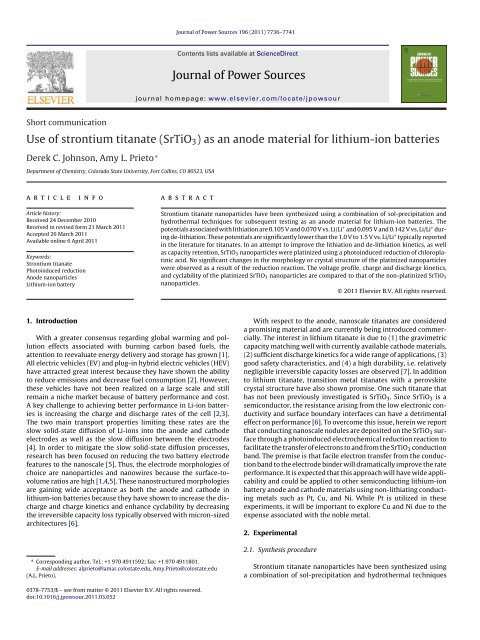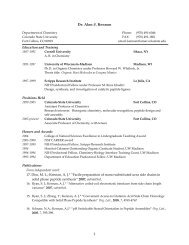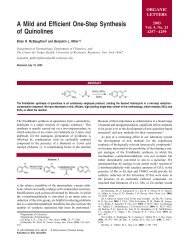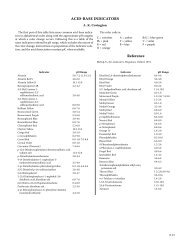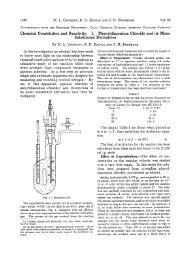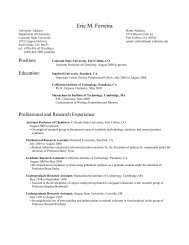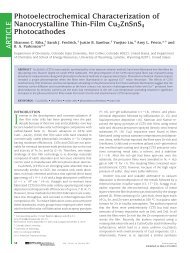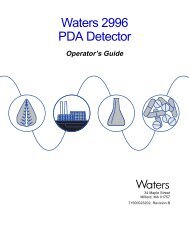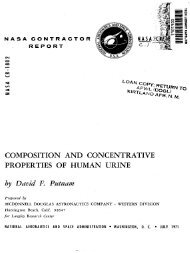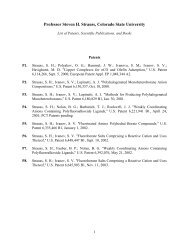(SrTiO3) as an anode material for lithium-ion batteries
(SrTiO3) as an anode material for lithium-ion batteries
(SrTiO3) as an anode material for lithium-ion batteries
Create successful ePaper yourself
Turn your PDF publications into a flip-book with our unique Google optimized e-Paper software.
Short communicat<strong>ion</strong><br />
Journal of Power Sources 196 (2011) 7736– 7741<br />
Contents lists available at ScienceDirect<br />
Journal of Power Sources<br />
jou rnal h omepa g e: www.elsevier.com/locate/jpowsour<br />
Use of strontium tit<strong>an</strong>ate (<strong>SrTiO3</strong>) <strong>as</strong> <strong>an</strong> <strong>an</strong>ode <strong>material</strong> <strong>for</strong> <strong>lithium</strong>-<strong>ion</strong> <strong>batteries</strong><br />
Derek C. Johnson, Amy L. Prieto ∗<br />
Department of Chemistry, Colorado State University, Fort Collins, CO 80523, USA<br />
a r t i c l e i n f o<br />
Article history:<br />
Received 24 December 2010<br />
Received in revised <strong>for</strong>m 21 March 2011<br />
Accepted 26 March 2011<br />
Available online 6 April 2011<br />
Keywords:<br />
Strontium tit<strong>an</strong>ate<br />
Photoinduced reduct<strong>ion</strong><br />
Anode n<strong>an</strong>oparticles<br />
Lithium-<strong>ion</strong> battery<br />
1. Introduct<strong>ion</strong><br />
a b s t r a c t<br />
With a greater consensus regarding global warming <strong>an</strong>d pollut<strong>ion</strong><br />
effects <strong>as</strong>sociated with burning carbon b<strong>as</strong>ed fuels, the<br />
attent<strong>ion</strong> to reevaluate energy delivery <strong>an</strong>d storage h<strong>as</strong> grown [1].<br />
All electric vehicles (EV) <strong>an</strong>d plug-in hybrid electric vehicles (HEV)<br />
have attracted great interest because they have shown the ability<br />
to reduce emiss<strong>ion</strong>s <strong>an</strong>d decre<strong>as</strong>e fuel consumpt<strong>ion</strong> [2]. However,<br />
these vehicles have not been realized on a large scale <strong>an</strong>d still<br />
remain a niche market because of battery per<strong>for</strong>m<strong>an</strong>ce <strong>an</strong>d cost.<br />
A key challenge to achieving better per<strong>for</strong>m<strong>an</strong>ce in Li-<strong>ion</strong> <strong>batteries</strong><br />
is incre<strong>as</strong>ing the charge <strong>an</strong>d discharge rates of the cell [2,3].<br />
The two main tr<strong>an</strong>sport properties limiting these rates are the<br />
slow solid-state diffus<strong>ion</strong> of Li-<strong>ion</strong>s into the <strong>an</strong>ode <strong>an</strong>d cathode<br />
electrodes <strong>as</strong> well <strong>as</strong> the slow diffus<strong>ion</strong> between the electrodes<br />
[4]. In order to mitigate the slow solid-state diffus<strong>ion</strong> processes,<br />
research h<strong>as</strong> been focused on reducing the two battery electrode<br />
features to the n<strong>an</strong>oscale [5]. Thus, the electrode morphologies of<br />
choice are n<strong>an</strong>oparticles <strong>an</strong>d n<strong>an</strong>owires because the surface-tovolume<br />
ratios are high [1,4,5]. These n<strong>an</strong>ostructured morphologies<br />
are gaining wide accept<strong>an</strong>ce <strong>as</strong> both the <strong>an</strong>ode <strong>an</strong>d cathode in<br />
<strong>lithium</strong>-<strong>ion</strong> <strong>batteries</strong> because they have shown to incre<strong>as</strong>e the discharge<br />
<strong>an</strong>d charge kinetics <strong>an</strong>d enh<strong>an</strong>ce cyclability by decre<strong>as</strong>ing<br />
the irreversible capacity loss typically observed with micron-sized<br />
architectures [6].<br />
∗ Corresponding author. Tel.: +1 970 4911592; fax: +1 970 4911801.<br />
E-mail addresses: alprieto@lamar.colostate.edu, Amy.Prieto@colostate.edu<br />
(A.L. Prieto).<br />
0378-7753/$ – see front matter ©<br />
2011 Elsevier B.V. All rights reserved.<br />
doi:10.1016/j.jpowsour.2011.03.052<br />
Strontium tit<strong>an</strong>ate n<strong>an</strong>oparticles have been synthesized using a combinat<strong>ion</strong> of sol-precipitat<strong>ion</strong> <strong>an</strong>d<br />
hydrothermal techniques <strong>for</strong> subsequent testing <strong>as</strong> <strong>an</strong> <strong>an</strong>ode <strong>material</strong> <strong>for</strong> <strong>lithium</strong>-<strong>ion</strong> <strong>batteries</strong>. The<br />
potentials <strong>as</strong>sociated with lithiat<strong>ion</strong> are 0.105 V <strong>an</strong>d 0.070 V vs. Li/Li + <strong>an</strong>d 0.095 V <strong>an</strong>d 0.142 V vs. Li/Li + during<br />
de-lithiat<strong>ion</strong>. These potentials are signific<strong>an</strong>tly lower th<strong>an</strong> the 1.0 V to 1.5 V vs. Li/Li + typically reported<br />
in the literature <strong>for</strong> tit<strong>an</strong>ates. In <strong>an</strong> attempt to improve the lithiat<strong>ion</strong> <strong>an</strong>d de-lithiat<strong>ion</strong> kinetics, <strong>as</strong> well<br />
<strong>as</strong> capacity retent<strong>ion</strong>, <strong>SrTiO3</strong> n<strong>an</strong>oparticles were platinized using a photoinduced reduct<strong>ion</strong> of chloroplatinic<br />
acid. No signific<strong>an</strong>t ch<strong>an</strong>ges in the morphology or crystal structure of the platinized n<strong>an</strong>oparticles<br />
were observed <strong>as</strong> a result of the reduct<strong>ion</strong> react<strong>ion</strong>. The voltage profile, charge <strong>an</strong>d discharge kinetics,<br />
<strong>an</strong>d cyclability of the platinized <strong>SrTiO3</strong> n<strong>an</strong>oparticles are compared to that of the non-platinized <strong>SrTiO3</strong><br />
n<strong>an</strong>oparticles.<br />
© 2011 Elsevier B.V. All rights reserved.<br />
With respect to the <strong>an</strong>ode, n<strong>an</strong>oscale tit<strong>an</strong>ates are considered<br />
a promising <strong>material</strong> <strong>an</strong>d are currently being introduced commercially.<br />
The interest in <strong>lithium</strong> tit<strong>an</strong>ate is due to (1) the gravimetric<br />
capacity matching well with currently available cathode <strong>material</strong>s,<br />
(2) sufficient discharge kinetics <strong>for</strong> a wide r<strong>an</strong>ge of applicat<strong>ion</strong>s, (3)<br />
good safety characteristics, <strong>an</strong>d (4) a high durability, i.e. relatively<br />
negligible irreversible capacity losses are observed [7]. In addit<strong>ion</strong><br />
to <strong>lithium</strong> tit<strong>an</strong>ate, tr<strong>an</strong>sit<strong>ion</strong> metal tit<strong>an</strong>ates with a perovskite<br />
crystal structure have also shown promise. One such tit<strong>an</strong>ate that<br />
h<strong>as</strong> not been previously investigated is SrTiO 3. Since SrTiO 3 is a<br />
semiconductor, the resist<strong>an</strong>ce arising from the low electronic conductivity<br />
<strong>an</strong>d surface boundary interfaces c<strong>an</strong> have a detrimental<br />
effect on per<strong>for</strong>m<strong>an</strong>ce [6]. To overcome this issue, herein we report<br />
that conducting n<strong>an</strong>oscale nodules are deposited on the SrTiO 3 surface<br />
through a photoinduced electrochemical reduct<strong>ion</strong> react<strong>ion</strong> to<br />
facilitate the tr<strong>an</strong>sfer of electrons to <strong>an</strong>d from the SrTiO 3 conduct<strong>ion</strong><br />
b<strong>an</strong>d. The premise is that facile electron tr<strong>an</strong>sfer from the conduct<strong>ion</strong><br />
b<strong>an</strong>d to the electrode binder will dramatically improve the rate<br />
per<strong>for</strong>m<strong>an</strong>ce. It is expected that this approach will have wide applicability<br />
<strong>an</strong>d could be applied to other semiconducting <strong>lithium</strong>-<strong>ion</strong><br />
battery <strong>an</strong>ode <strong>an</strong>d cathode <strong>material</strong>s using non-lithiating conducting<br />
metals such <strong>as</strong> Pt, Cu, <strong>an</strong>d Ni. While Pt is utilized in these<br />
experiments, it will be import<strong>an</strong>t to explore Cu <strong>an</strong>d Ni due to the<br />
expense <strong>as</strong>sociated with the noble metal.<br />
2. Experimental<br />
2.1. Synthesis procedure<br />
Strontium tit<strong>an</strong>ate n<strong>an</strong>oparticles have been synthesized using<br />
a combinat<strong>ion</strong> of sol-precipitat<strong>ion</strong> <strong>an</strong>d hydrothermal techniques
D.C. Johnson, A.L. Prieto / Journal of Power Sources 196 (2011) 7736– 7741 7737<br />
Fig. 1. React<strong>ion</strong> scheme <strong>for</strong> the co-precipitat<strong>ion</strong>/solvothermal synthesis of <strong>SrTiO3</strong> n<strong>an</strong>oparticles <strong>an</strong>d subsequent photoinduced reduct<strong>ion</strong> of chloroplatinic acid on the <strong>SrTiO3</strong><br />
n<strong>an</strong>oparticle surface.<br />
<strong>for</strong> which the react<strong>ion</strong> mech<strong>an</strong>ism is contained in Fig. 1 [8]. Using<br />
st<strong>an</strong>dard Schlenk line techniques, two solut<strong>ion</strong>s, a 5% TiCl 4 (99.9%,<br />
Aldrich) in ethyl alcohol (200 proof ACS grade, Pharmco-Aaper) <strong>an</strong>d<br />
a 0.2 M Sr(OH) 2·8H 2O (95%, Aldrich) in 1 M acetic acid (aq.) (ACS,<br />
Mallinckrodt chemicals), were prepared. While vigorously stirring,<br />
the solut<strong>ion</strong>s were combined. The resulting white slurry w<strong>as</strong> tr<strong>an</strong>sferred<br />
to a 23 mL PTFE lined acid digest<strong>ion</strong> vessel (Parr, 4749).<br />
The vessel w<strong>as</strong> heated at 4 ◦ C min −1 to 240 ◦ C <strong>an</strong>d held <strong>for</strong> 12 h.<br />
The resulting product w<strong>as</strong> centrifuged, dec<strong>an</strong>ted, <strong>an</strong>d sonicated in<br />
Millipore ® water at le<strong>as</strong>t three times to separate the n<strong>an</strong>oparticles<br />
from react<strong>ion</strong> byproducts. The n<strong>an</strong>oparticles were platinized<br />
by irradiating at 254 nm in the presence of H 2PtCl 6 (99.995%,<br />
Aldrich), methyl alcohol (99.9%, Sigma Aldrich), <strong>an</strong>d Millipore ®<br />
water similarly to that reported in the literature [9–11]. React<strong>ion</strong><br />
byproducts were removed using the same procedure <strong>as</strong> described<br />
above.<br />
2.2. N<strong>an</strong>oparticle characterizat<strong>ion</strong><br />
The n<strong>an</strong>oparticles were characterized by tr<strong>an</strong>smiss<strong>ion</strong> electron<br />
microscopy (TEM), selected-area electron diffract<strong>ion</strong> (SAED), powder<br />
X-ray diffract<strong>ion</strong> (XRD), <strong>an</strong>d X-ray photoelectron spectroscopy<br />
(XPS). TEM images were obtained using a JEOL JEM-2000 tr<strong>an</strong>smiss<strong>ion</strong><br />
electron microscope operating under <strong>an</strong> accelerating voltage<br />
of 160 kV. Powder XRD patterns were collected on a Scintag X-<br />
2 Adv<strong>an</strong>ced Diffract<strong>ion</strong> System equipped with Cu K radiat<strong>ion</strong><br />
with a wavelength of 1.54 nm. XPS spectra were obtained using<br />
a Physical Electronics ESCA 5800 system employing monochromatic<br />
Al K (E = 1486.6 eV) <strong>as</strong> the X-ray source. High resolut<strong>ion</strong><br />
sc<strong>an</strong>s were utilized to confirm the presence <strong>an</strong>d provide in<strong>for</strong>mat<strong>ion</strong><br />
regarding the bonding environment <strong>an</strong>d oxidat<strong>ion</strong> state of Sr,<br />
Ti, O, Pt, <strong>an</strong>d Cl. These sc<strong>an</strong>s were per<strong>for</strong>med with a p<strong>as</strong>s energy of<br />
23.5 eV <strong>an</strong>d a step size of 0.10 eV step −1 . All spectra were shifted to<br />
Fig. 2. (a) Characteristic TEM image of synthesized <strong>SrTiO3</strong> n<strong>an</strong>oparticles with (b) corresponding indexed SAED pattern. (c) Higher magnificat<strong>ion</strong> TEM image illustrating the<br />
cubic morphology.
7738 D.C. Johnson, A.L. Prieto / Journal of Power Sources 196 (2011) 7736– 7741<br />
Fig. 3. (a) Characteristic TEM image of <strong>as</strong>-synthesized Pt-<strong>SrTiO3</strong> n<strong>an</strong>oparticles with (b) a high magnificat<strong>ion</strong> TEM image illustrating Pt nodules on the surface due to the<br />
photoinduced reduct<strong>ion</strong> of chloroplatinic acid. (c) Corresponding indexed SAED pattern of the platinized <strong>SrTiO3</strong> n<strong>an</strong>oparticles.<br />
account <strong>for</strong> sample charging using graphitic carbon <strong>as</strong> a reference<br />
to 284.80 eV. Preliminary cycling data w<strong>as</strong> acquired using a Maccor<br />
model 4200 battery cycler in a two electrode half cell with <strong>lithium</strong><br />
metal <strong>as</strong> the negative electrode <strong>an</strong>d SrTiO 3 n<strong>an</strong>oparticles in a binder<br />
<strong>as</strong> the positive electrode. The positive electrode w<strong>as</strong> prepared by<br />
combining 60% 1-methyl-2-pyrolidinone (99+%, Sigma–Aldrich),<br />
28% SrTiO 3, 8% graphite (Fluka), <strong>an</strong>d 4% poly(vinylidene fluoride)<br />
(PVDF) (Aldrich, MW = 530k) by weight. The resulting slurry w<strong>as</strong><br />
spread on copper foil <strong>an</strong>d heated to 60 ◦ C under air <strong>for</strong> 1 h <strong>an</strong>d<br />
at 110 ◦ C under vacuum <strong>for</strong> 90 min. The liquid electrolyte in all<br />
electrochemical cells consisted of 1 M LiClO 4 in a 1:1:1 by volume<br />
solut<strong>ion</strong> of dimethyl carbonate, diethyl carbonate, <strong>an</strong>d ethylene<br />
carbonate. The geometric electrode surface area <strong>for</strong> all SrTiO 3 <strong>an</strong>d<br />
Pt-SrTiO 3 cycling experiments w<strong>as</strong> 1.27 cm 2 . The platinized <strong>an</strong>d<br />
non-platinized strontium tit<strong>an</strong>ate half cells were cycled between<br />
0.050 V <strong>an</strong>d 1.0 V vs. Li/Li + <strong>an</strong>d contained <strong>an</strong> average of 0.023 g of<br />
active <strong>material</strong>. In addit<strong>ion</strong>, <strong>an</strong> electrode without active <strong>material</strong>,<br />
i.e. consisting of only PVDF binder <strong>an</strong>d graphite, w<strong>as</strong> also cycled to<br />
determine the contribut<strong>ion</strong> from the graphite. The geometric surface<br />
area <strong>for</strong> this cell w<strong>as</strong> 0.32 cm 2 <strong>an</strong>d contained 1.8 mg of graphite.<br />
The graphite cell w<strong>as</strong> cycled from 2 V to 0.005 V vs. Li/Li + .<br />
3. Results <strong>an</strong>d discuss<strong>ion</strong><br />
Fig. 2 contains characteristic TEM images <strong>an</strong>d a SAED pattern<br />
of SrTiO 3 synthesized following the procedure described above. As<br />
demonstrated by Fig. 2(a), the average particle diameter is sub-<br />
100 nm. The SAED pattern contained in Fig. 2(b) w<strong>as</strong> indexed to<br />
Tausonite, cubic SrTiO 3. All rings were indexed, but only the (1 1 0),<br />
(1 1 1), <strong>an</strong>d (2 0 0) pl<strong>an</strong>es are labeled <strong>for</strong> clarity. The characteristic<br />
high resolut<strong>ion</strong> TEM image in Fig. 2(c) visually demonstrates<br />
the cubic nature of the crystals. To determine if the platinizat<strong>ion</strong><br />
process affects the crystal properties or ch<strong>an</strong>ges the particle morphology,<br />
the same characterizat<strong>ion</strong> w<strong>as</strong> per<strong>for</strong>med <strong>for</strong> Pt-SrTiO 3<br />
n<strong>an</strong>ocrystals synthesized using the above described procedure.<br />
Fig. 3 contains characteristic TEM images <strong>an</strong>d a SAED pattern of<br />
Pt-SrTiO 3. As illustrated in Fig. 3(a), the platinizat<strong>ion</strong> process does<br />
not signific<strong>an</strong>tly alter the n<strong>an</strong>oparticle morphology <strong>as</strong> the particles<br />
are still cubic with a sub-100 nm diameter. A striking difference<br />
between the platinized <strong>an</strong>d non-platinized SrTiO 3, highlighted by<br />
the high resolut<strong>ion</strong> TEM image in Fig. 3(b), is that Pt-SrTiO 3 contains<br />
Pt nodules on the particle surface that r<strong>an</strong>ge in size from approximately<br />
1 to 5 nm. As with the non-platinized particles, the SAED<br />
pattern contained in Fig. 3(c) c<strong>an</strong> be indexed to tausonite, but only<br />
the (1 1 0), (1 1 1), <strong>an</strong>d (2 0 0) pl<strong>an</strong>es are labeled <strong>for</strong> clarity. Focusing<br />
on the (1 1 1) <strong>an</strong>d (2 0 0) pl<strong>an</strong>es, ring broadening is observed due to<br />
the presence of cubic platinum. To further confirm the purity <strong>an</strong>d<br />
crystal structure of the SrTiO 3 <strong>as</strong> well <strong>as</strong> the presence of metallic<br />
Pt, XRD <strong>an</strong>d XPS characterizat<strong>ion</strong> techniques were used.<br />
Fig. 4(a) <strong>an</strong>d (b) contains powder XRD patterns that have been<br />
indexed to SrTiO 3 (PDF #00-035-0734) <strong>an</strong>d Pt-SrTiO 3 (Pt PDF<br />
#03-065-2868), respectively. The patterns are essentially identical<br />
except <strong>for</strong> the fact that the Pt-SrTiO 3 pattern contains peaks at<br />
approximately 40 ◦ <strong>an</strong>d 46 ◦ 2-theta that are <strong>as</strong>ymmetric with shoulders<br />
at higher 2-theta. These shoulders c<strong>an</strong> be attributed to the<br />
presence of the Pt nodules on the surface of the SrTiO 3 n<strong>an</strong>oparticles.<br />
There<strong>for</strong>e, the ex situ photoinduced reduct<strong>ion</strong> of chloroplatinic<br />
acid does not signific<strong>an</strong>tly ch<strong>an</strong>ge the XRD pattern with the excep-
t<strong>ion</strong> of Pt peaks, of which the Pt(1 1 1) pl<strong>an</strong>e is highlighted in<br />
Fig. 4(b). A Scherrer <strong>an</strong>alysis on the (1 1 0) pl<strong>an</strong>e suggests that the<br />
average particle diameter is approximately 100 nm. This <strong>an</strong>alysis<br />
further corroborates the data <strong>an</strong>d conclus<strong>ion</strong>s drawn from the electron<br />
microscopy characterizat<strong>ion</strong> of the n<strong>an</strong>oparticles. To confirm<br />
that the Pt is zero valent, the chlorine byproducts were removed,<br />
<strong>an</strong>d the platinizat<strong>ion</strong> process did not affect the surface binding<br />
environment of the SrTiO 3, XPS <strong>an</strong>alysis of the platinized <strong>an</strong>d nonplatinized<br />
samples were conducted.<br />
Fig. 5(a) contains survey sc<strong>an</strong>s of SrTiO 3, chloroplatinic acid, <strong>an</strong>d<br />
Pt-SrTiO 3. Sr, Ti, <strong>an</strong>d O are identified in both the SrTiO 3 <strong>an</strong>d Pt-<br />
SrTiO 3 spectra while Pt is identified in the chloroplatinic acid <strong>an</strong>d<br />
Pt-SrTiO 3 spectra. Cl w<strong>as</strong> only identified in the chloroplatinic acid<br />
survey sc<strong>an</strong>. High resolut<strong>ion</strong> sc<strong>an</strong>s of Ti, Sr, O, Pt, <strong>an</strong>d Cl were also<br />
collected <strong>an</strong>d are plotted in Fig. 5(b)–(f), respectively, to determine<br />
the element oxidat<strong>ion</strong> state <strong>an</strong>d ch<strong>an</strong>ges in chemical binding environment.<br />
No observable differences in the Ti, Sr, or O XPS spectra<br />
D.C. Johnson, A.L. Prieto / Journal of Power Sources 196 (2011) 7736– 7741 7739<br />
Fig. 4. Indexed powder XRD patterns <strong>for</strong> (a) <strong>SrTiO3</strong> <strong>an</strong>d (b) platinized <strong>SrTiO3</strong>.<br />
were detected when comparing SrTiO 3 <strong>an</strong>d Pt-SrTiO 3. This suggests<br />
that neither the oxidat<strong>ion</strong> state nor the surface binding environment<br />
of the three elements ch<strong>an</strong>ges <strong>as</strong> a result of the photoinduced<br />
reduct<strong>ion</strong> of chloroplatinic acid on the SrTiO 3 surface. However,<br />
high resolut<strong>ion</strong> spectra of Pt contained in Fig. 5(e) <strong>for</strong> both the<br />
platinized SrTiO 3 <strong>an</strong>d chloroplatinic acid indicate that both the oxidat<strong>ion</strong><br />
state <strong>an</strong>d the binding environment ch<strong>an</strong>ge <strong>as</strong> a result of the<br />
photoinduced reduct<strong>ion</strong> of chloroplatinic acid. The top spectrum<br />
is indicative of metallic Pt while the bottom spectrum is indicative<br />
of Pt 4+ in two different bonding environments [12]. The high<br />
resolut<strong>ion</strong> sc<strong>an</strong> of Cl contained in Fig. 5(f) demonstrates that the<br />
chlorine byproducts have been effectively removed. Now that it h<strong>as</strong><br />
been confirmed that metallic, non-lithiating Pt h<strong>as</strong> been selectively<br />
deposited onto the SrTiO 3 surface with the purpose of improving<br />
electronic tr<strong>an</strong>sport properties within the binder matrix, the lithiat<strong>ion</strong><br />
<strong>an</strong>d rate per<strong>for</strong>m<strong>an</strong>ce of platinized <strong>an</strong>d non-platinized SrTiO 3<br />
are compared.<br />
Fig. 5. (a) XPS spectra from survey sc<strong>an</strong>s of <strong>SrTiO3</strong>, chloroplatinic acid, <strong>an</strong>d Pt-<strong>SrTiO3</strong>. High resolut<strong>ion</strong> spectra <strong>for</strong> Ti, Sr, O, Pt, <strong>an</strong>d Cl are plotted in (b), (c), (d), (e), <strong>an</strong>d (f),<br />
respectively.
7740 D.C. Johnson, A.L. Prieto / Journal of Power Sources 196 (2011) 7736– 7741<br />
Fig. 6. (a) Charge <strong>an</strong>d discharge curves of <strong>an</strong> electrode that contains only graphite <strong>an</strong>d PVDF binder without <strong>an</strong>ode active <strong>material</strong>. (b) A slow charge <strong>an</strong>d discharge curve of<br />
<strong>SrTiO3</strong> at a rate of 0.015 mA cm −2 in a half cell to highlight the intercalat<strong>ion</strong> <strong>an</strong>d deintercalat<strong>ion</strong> plateaus. (c) Voltage profiles of <strong>SrTiO3</strong> <strong>an</strong>d Pt-<strong>SrTiO3</strong> at rates of 0.19, 0.38, <strong>an</strong>d<br />
0.95 mA cm −2 to highlight the difference in capacity <strong>as</strong> a funct<strong>ion</strong> of cycle number. Cycles 16–30 <strong>for</strong> both <strong>SrTiO3</strong> <strong>an</strong>d Pt-<strong>SrTiO3</strong> are not included in the plot <strong>for</strong> clarity with the<br />
except<strong>ion</strong> of cycle 16 <strong>for</strong> Pt-<strong>SrTiO3</strong>, which illustrates the maximum capacity of the cycles excluded from the plot. (d) A plot of the discharge capacity retent<strong>ion</strong> <strong>as</strong> a funct<strong>ion</strong><br />
of cycle number <strong>an</strong>d rate <strong>for</strong> <strong>SrTiO3</strong> <strong>an</strong>d Pt-<strong>SrTiO3</strong>. One hundred percent discharge capacities are b<strong>as</strong>ed on a rate of 0.19 mA cm −2 , <strong>an</strong>d are 52.7 mAh g −1 <strong>an</strong>d 24.8 mAh g −1 <strong>for</strong><br />
Pr-<strong>SrTiO3</strong> <strong>an</strong>d <strong>SrTiO3</strong>, respectively.<br />
Be<strong>for</strong>e the platinized <strong>an</strong>d non-platinized SrTiO 3 samples c<strong>an</strong><br />
be compared, the effect of graphite used in the cells on the electrochemical<br />
per<strong>for</strong>m<strong>an</strong>ce must be elucidated. Voltage profiles <strong>as</strong> a<br />
funct<strong>ion</strong> of cycle number <strong>for</strong> a cell consisting of graphite <strong>an</strong>d PVDF<br />
binder are contained in Fig. 6(a). Briefly, because the graphite used<br />
<strong>as</strong> the conductive additive in the binder is not a very high grade, its<br />
capacity retent<strong>ion</strong> <strong>an</strong>d contribut<strong>ion</strong> to the electrochemical properties<br />
of the cell in terms of <strong>lithium</strong> intercalat<strong>ion</strong> <strong>an</strong>d de-intercalat<strong>ion</strong><br />
is minimal. This is especially true after the first cycle <strong>an</strong>d at higher<br />
charge <strong>an</strong>d discharge rates. Fig. 6(b) contains a charge <strong>an</strong>d discharge<br />
curve of SrTiO 3 highlighting two distinct <strong>an</strong>d <strong>an</strong> obscure plateau<br />
<strong>for</strong> each half cycle at a rate of approximately 0.015 mA cm −2 . The<br />
potentials <strong>as</strong>sociated with the intercalat<strong>ion</strong> plateaus are 0.18 V,<br />
0.105 V <strong>an</strong>d 0.070 V vs. Li/Li + <strong>an</strong>d 0.095 V, 0.142 V, <strong>an</strong>d 0.21 vs. Li/Li +<br />
during the deintercalat<strong>ion</strong> of Li-<strong>ion</strong>s. These potentials are signific<strong>an</strong>tly<br />
lower th<strong>an</strong> the 1.0 V to 1.5 V vs. Li/Li + typically reported in<br />
the literature <strong>for</strong> tit<strong>an</strong>ates, <strong>an</strong>d are positive of the potential needed<br />
to plate <strong>lithium</strong> metal. At this slow discharge rate, a capacity of<br />
approximately 135 mAh g −1 c<strong>an</strong> be achieved. This is 87% of the<br />
theoretical capacity, 155.9 mAh g −1 , when two moles of <strong>lithium</strong><br />
c<strong>an</strong> be intercalated per mole of SrTiO 3. However, the percentage<br />
of capacity recovered when compared to the theoretical capacity<br />
quickly decre<strong>as</strong>es when the cycling rate is incre<strong>as</strong>ed. In <strong>an</strong> attempt<br />
to improve the lithiat<strong>ion</strong> <strong>an</strong>d de-lithiat<strong>ion</strong> kinetics, <strong>as</strong> well <strong>as</strong> the<br />
cyclability, SrTiO 3 n<strong>an</strong>oparticles were platinized with a Pt loading<br />
of less th<strong>an</strong> 1% by weight using a photoinduced reduct<strong>ion</strong> of chloroplatinic<br />
acid. As demonstrated by Fig. 6(c), the Pt-SrTiO 3 retains a<br />
2-fold higher capacity when compared to SrTiO 3. This trend continues<br />
<strong>for</strong> varying discharge rates <strong>as</strong> highlighted by Fig. 6(d) which<br />
contains a plot of the capacity retent<strong>ion</strong> <strong>as</strong> a funct<strong>ion</strong> of discharge<br />
rate. B<strong>as</strong>ed on the preliminary cycling data presented in Fig. 6, it is<br />
clear that <strong>for</strong> this semiconducting <strong>material</strong>, the deposit<strong>ion</strong> of Pt on<br />
the SrTiO 3 surface helps facilitate electron tr<strong>an</strong>sfer thereby improving<br />
the capacity retent<strong>ion</strong> <strong>an</strong>d rate per<strong>for</strong>m<strong>an</strong>ce of this potential<br />
Li-<strong>ion</strong> battery <strong>an</strong>ode <strong>material</strong>.<br />
4. Conclus<strong>ion</strong>s<br />
The photoinduced react<strong>ion</strong> of inert metals onto the surface of<br />
semiconducting, active <strong>an</strong>ode <strong>material</strong>s c<strong>an</strong> enh<strong>an</strong>ce the rate per<strong>for</strong>m<strong>an</strong>ce<br />
<strong>an</strong>d capacity retent<strong>ion</strong> because the inert metal helps<br />
facilitate the tr<strong>an</strong>sfer of electrons from the semiconductor to the<br />
conducting binder. B<strong>as</strong>ed on the potential required <strong>for</strong> lithiat<strong>ion</strong>,<br />
0.105 V <strong>an</strong>d 0.070 V vs. Li/Li + , it is plausible that the Sr is being<br />
reduced thereby <strong>for</strong>ming Li 2TiO 3 in a two step react<strong>ion</strong> process.<br />
Further experiments need to be conducted to confirm this <strong>an</strong>alysis<br />
<strong>an</strong>d to determine the relat<strong>ion</strong>ship between Pt loading <strong>an</strong>d the corresponding<br />
incre<strong>as</strong>e in rate per<strong>for</strong>m<strong>an</strong>ce <strong>an</strong>d capacity retent<strong>ion</strong>.<br />
In addit<strong>ion</strong>, non-noble metals should also be explored so to not<br />
adversely affect the cost of the electrode.
Acknowledgments<br />
The authors’ would like to th<strong>an</strong>k Colorado State University <strong>an</strong>d<br />
Prieto Battery, Inc. <strong>for</strong> research funds <strong>as</strong> well <strong>as</strong> the Microscope<br />
Imaging Network core infr<strong>as</strong>tructure gr<strong>an</strong>t from Colorado State<br />
University.<br />
References<br />
[1] J.B. Goodenough, Y. Kim, Chem. Mater. 22 (2010) 587–603.<br />
[2] L. Gaines, R. Cuenca, Costs of Lithium-Ion Batteries <strong>for</strong> Vehicles, Argonne<br />
Nat<strong>ion</strong>al Laboratory, Department of Energy, Argonne, IL, 2000.<br />
[3] P. Arora, Z.M. Zh<strong>an</strong>g, Chem. Rev. 104 (2004) 4419–4462.<br />
D.C. Johnson, A.L. Prieto / Journal of Power Sources 196 (2011) 7736– 7741 7741<br />
[4] B. Scrosati, J. Garche, J. Power Sources 195 (2010) 2419–2430.<br />
[5] E. Serr<strong>an</strong>o, G. Rus, J. Garcia-Martinez, Renew. Sust. Energy Rev. 13 (2009)<br />
2373–2384.<br />
[6] Y. W<strong>an</strong>g, H. Li, P. He, E. Hosono, H. Zhou, N<strong>an</strong>oscale 2 (2010) 1294–1305.<br />
[7] A.Y. Shenouda, K.R. Murali, J. Power Sources 176 (2008) 332–339.<br />
[8] F.A. Rabuffetti, H.S. Kim, J.A. Enterkin, Y. W<strong>an</strong>g, C.H. L<strong>an</strong>ier, L.D. Marks, K.R.<br />
Poeppelmeier, P.C. Stair, Chem. Mater. 20 (2008) 5628–5635.<br />
[9] F.B. Li, X.Z. Li, Chemosphere 48 (2002) 1103–1111.<br />
[10] J.C. Y<strong>an</strong>g, Y.C. Kim, Y.G. Shul, C.H. Shin, T.K. Lee, Appl. Surf. Sci. 121 (1997)<br />
525–529.<br />
[11] L. Ravich<strong>an</strong>dr<strong>an</strong>, K. Selvam, B. Krishnakumar, M. Swaminath<strong>an</strong>, J. Hazard. Mater.<br />
167 (2009) 763–769.<br />
[12] J.F. Moulder, W.F. Stickle, P.E. Sobol, K.D. Bomben, H<strong>an</strong>dbook of X-ray Photoelectron<br />
Spectroscopy: A Reference Book of St<strong>an</strong>dard Spectra <strong>for</strong> Identificat<strong>ion</strong><br />
<strong>an</strong>d Interpretat<strong>ion</strong> of XPS Data, Physical Electronics, Eden Prairie, MN, 1995.


